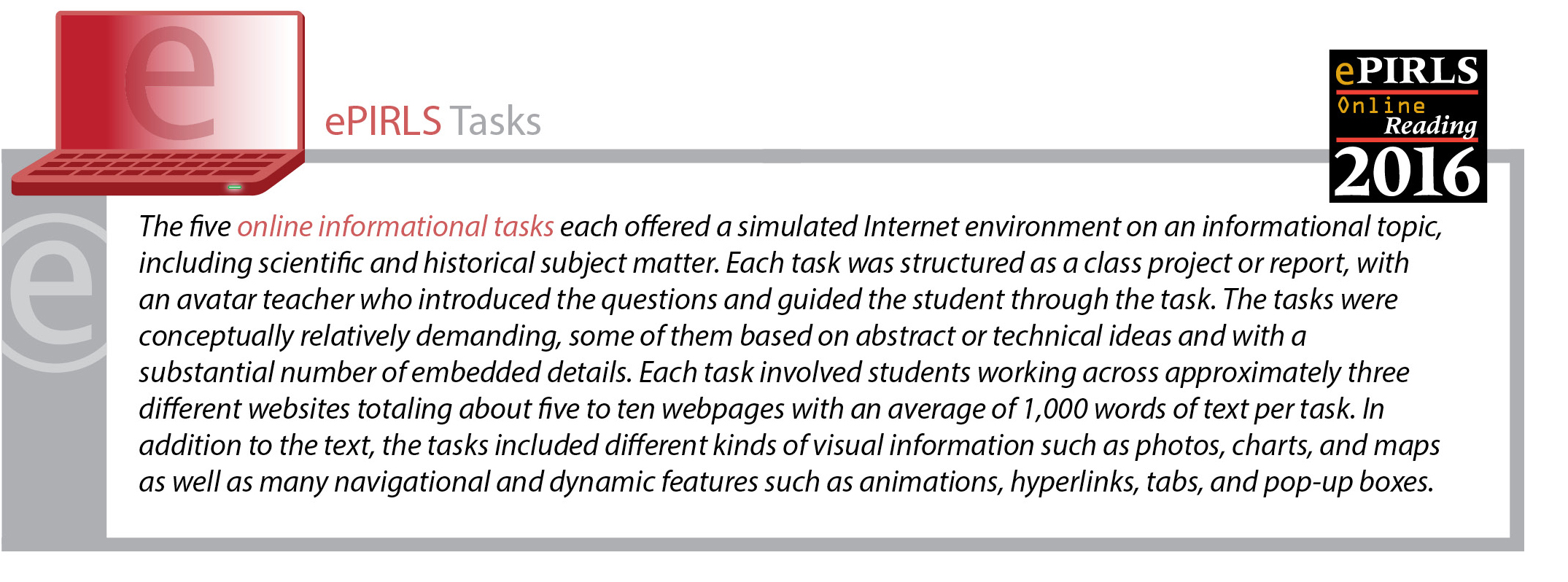ePIRLS Benchmarking at the PIRLS International Benchmarks
For PIRLS 2016, the scale anchoring analysis was conducted for ePIRLS as well as PIRLS. This enabled reporting descriptions of ePIRLS achievement at the Advanced, High, Intermediate, and Low Benchmarks.
Overview of the ePIRLS 2016 Tasks and Items
The ePIRLS tasks and items used in 2016 were selected and developed based on the PIRLS 2016 Assessment Framework. The framework describes the PIRLS view of reading as an interactive process between the text and the reader and describes the ways that PIRLS measures students’ reading achievement. It specifies that the assessment texts and items should cover in equal amounts the two purposes that account for most of the reading done by young students in and out of school: literary and informational. The ePIRLS tasks assess reading for informational purposes, but on the Internet in an environment of interconnected webpages and a variety of visual and textual elements.
Just like PIRLS, the items accompanying the ePIRLS informational tasks measure four processes of comprehension: retrieving, straightforward inferencing, interpreting and integrating, and evaluating and critiquing. These are collapsed into two processes for reporting: retrieving and straightforward inferencing and interpreting, integrating, and evaluating.
Description of the ePIRLS Tasks Assessing Online Informational Reading
There were five ePIRLS tasks simulating online informational reading similar to what might be required for school projects and reports. They were about science or social studies topics, including: “Mars,” “Elizabeth Blackwell (the first woman doctor),” “Rainforests,” “Troy,” and “Animal Migration.” Two of the tasks—“Mars” and “Elizabeth Blackwell”—are released to provide examples of the ePIRLS tasks. To see the released examples, watch the ePIRLS 2016 Example Tasks video or Take the ePIRLS Assessment. Taking the ePIRLS test includes both released tasks in their entirety as they were given to students. You can type in your answers, and the scoring guides are provided at the end so you can check your answers.
An overview of the ePIRLS tasks is provided below.

Description of ePIRLS Achievement at the PIRLS International Benchmarks
The interactive graphic shows the descriptions of ePIRLS achievement demonstrated by fourth grade students at each of the four International Benchmarks.

When reading and viewing relatively complex Online Informational Texts, students can:
- Make inferences from complex information to support an explanation
- Interpret and integrate information from within and across webpages with interactive features to explain relationships, and show thorough understanding
- Evaluate the effects of textual, visual, and interactive elements and begin to consider the writer’s point of view
When reading and viewing relatively complex Online Informational Texts, students can:
- Make inferences to distinguish relevant information and provide comparisons
- Interpret and integrate information within and across webpages with interactive features to provide examples and make contrasts
- Evaluate how graphic elements and language choices support content
When reading and viewing relatively complex Online Informational Texts, students can:
- Locate and reproduce information presented in various forms including independent use of navigation features
- Make straightforward inferences to recognize reasons and actions
- Interpret and integrate information across a webpage to recognize causes, comparisons, and explanations
- Begin to evaluate the use of interactive features to convey information
When reading and viewing relatively complex Online Informational Texts, students can:
- Locate and reproduce explicitly stated information from webpages that contain text and a variety of dynamic, navigable features (e.g., timelines, pop-up boxes)
- Begin to make straightforward inferences about descriptions

